Highgate Cemetery
Highgate Cemetery is a place of burial in north London, England. There are approximately 170,000 people buried in around 53,000 graves across the West Cemetery and the East Cemetery at Highgate Cemetery.[1] Highgate Cemetery is notable both for some of the people buried there as well as for its de facto status as a nature reserve. The Cemetery is designated Grade I on the Register of Historic Parks and Gardens.[2][3] It is one of the Magnificent Seven cemeteries in London.
 Highgate (East) Cemetery (c. 2010) | |
| Details | |
|---|---|
| Established | 1839 |
| Location | |
| Country | England |
| Coordinates | 51°34′01″N 0°08′49″W |
| Owned by | Friends of Highgate Cemetery Trust |
| Size | 15 hectares (37 acres) |
| No. of graves | 53,000+ |
| No. of interments | 170,000 |
| Website | highgate-cemetery |
| Find a Grave | East, West |

Location
The cemetery comprises two sites on either side of Swains Lane in Highgate, N6, next to Waterlow Park. The main gate is located on Swains Lane just north of Oakshott Avenue. There is another disused gate on Chester Road. The cemetery is in the London Boroughs of Camden, Haringey and Islington. The nearest transport link is Transport for London C11 bus Brookfield Park stop or Archway tube station.
History and setting
The cemetery in its original form—the northwestern wooded area—opened in 1839, as part of a plan to provide seven large, modern cemeteries, now known as the "Magnificent Seven", around the outside of central London. The inner-city cemeteries, mostly the graveyards attached to individual churches, had long been unable to cope with the number of burials and were seen as a hazard to health and an undignified way to treat the dead. The initial design was by architect and entrepreneur Stephen Geary.
On Monday 20 May 1839, Highgate (West) Cemetery was dedicated to St. James[4] by the Right Reverend Charles James Blomfield, Lord Bishop of London. Fifteen acres were consecrated for the use of the Church of England, and two acres set aside for Dissenters. Rights of burial were sold for either limited period or in perpetuity. The first burial was Elizabeth Jackson of Little Windmill Street, Soho, on 26 May.
Highgate, like the others of the Magnificent Seven, soon became a fashionable place for burials and was much admired and visited. The Victorian attitude to death and its presentation led to the creation of a wealth of Gothic tombs and buildings. It occupies a spectacular south-facing hillside site slightly downhill from the top of the hill of Highgate itself, next to Waterlow Park. In 1854 the area to the east of the original area across Swains Lane was bought to form the eastern part of the cemetery. Both the cemeteries are still used today for burials, but these areas are closed to the public. Most of the open unforested area in the East Cemetery still has fairly few graves on it.
The cemetery's grounds are full of trees, shrubbery and wildflowers, most of which have been planted and grown without human influence. The grounds are a haven for birds and small animals such as foxes.
Because of the Karl Marx association a variety of socialist leaders and thinkers are buried within the cemetery grounds.
Highgate Cemetery was featured in the popular media from the 1960s to the late 1980s for its so-called occult past, particularly as being the alleged site of the "Highgate Vampire".
Friends of Highgate Cemetery
The Friends of Highgate Cemetery Trust was set up in 1975 and acquired the freehold of both East and West Cemeteries by 1981, since when they have had responsibility for the maintenance of the location. In 1984 they published Highgate Cemetery: Victorian Valhalla by John Gay.[5]
East Cemetery
.jpg.webp)
Many famous or prominent people are buried in Highgate cemetery; the most famous burial is arguably that of Karl Marx, whose tomb was the site of attempted bombings on 2 September 1965[6] and in 1970.[7] The tomb of Karl Marx is a Grade I listed building for reasons of historical importance.
East Cemetery interments

- Douglas Adams, author of The Hitchhiker's Guide to the Galaxy and other novels
- Farzad Bazoft, journalist, executed by Saddam Hussein's regime
- Jeremy Beadle, television presenter
- Adolf Beck, the Adolph Beck case was a celebrated case of mistaken identity
- Hercules Bellville, American film producer
- Kate Booth, English Salvationist and evangelist. Oldest daughter of William and Catherine Booth. She was also known as la Maréchale
- Sir Thomas Lauder Brunton, 1st Baronet, Scottish physician who is most-closely associated with the treatment of angina pectoris
- Patrick Caulfield, painter and printmaker known for his pop art canvasses
- William Kingdon Clifford (with his wife Lucy), mathematician and philosopher
- Lucy Lane Clifford, novelist and journalist, wife of William Kingdon Clifford
- Yusuf Dadoo, South African anti-apartheid activist
- Sir Davison Dalziel, Bt, British newspaper owner and Conservative Party politician. Massive mausoleum near the entrance.
- George Eliot (Mary Ann Evans – the name on the grave is Mary Ann Cross), novelist, common law wife of George Henry Lewes and buried next to him
- Paul Foot, campaigning journalist and nephew of former Labour Party leader Michael Foot
- William Foyle, co-founder of Foyles
- William Friese-Greene, cinema pioneer and his son Claude Friese-Greene
- Lou Gish, actress, daughter of Sheila Gish
- Sheila Gish, actress
- Philip Gould, British political consultant, and former advertising executive, closely linked to the Labour Party
- Robert Grant VC, soldier and police constable
- Charles Green, the United Kingdom's most famous balloonist of the 19th century
- Leon Griffiths, creator of Minder
- Mansoor Hekmat, Communist leader and founder of the Worker-Communist Party of Iran and Worker-Communist Party of Iraq
- Eric Hobsbawm, historian
- George Holyoake, Birmingham-born social reformer and founder of the Cooperative Movement
- Alan Howard, actor
- Leslie Hutchinson, Cabaret star of the 20s and 30s
- Anatoly Kuznetsov, Soviet writer
- Georges Jacobi, composer and conductor
- Bert Jansch, Scottish folk musician
- Claudia Jones, Communist and fighter for civil rights, founder of The West Indian Gazette and the Notting Hill Carnival
- George Henry Lewes, English philosopher and critic, common law husband of George Eliot and buried next to her.
- Roger Lloyd-Pack, British actor
- Charles Lucy, British artist, (1814-1873) whose most notable painting was The Landing of the Pilgrim Fathers
- Anna Mahler, sculptress and daughter of Gustav Mahler and Alma Schindler
- Karl Marx, philosopher, historian, sociologist and economist (memorial after his reburial, with other family members)
- Frank Matcham, theatre architect
- Carl Mayer, Austro-German screenwriter of The Cabinet of Doctor Caligari and Sunrise
- Malcolm McLaren, punk impresario and original manager of the Sex Pistols
- Ralph Miliband, left wing political theorist, father of David Miliband and Ed Miliband
- William Henry Monk, composer (of the music to Abide with Me)
- Sir Sidney Nolan, Australian artist
- Tim Pigott-Smith, actor
- Dachine Rainer, poet and anarchist
- Corin Redgrave, actor and political activist
- Bruce Reynolds, (ashes) English criminal
- Sir Ralph Richardson, actor
- José Carlos Rodrigues, Brazilian journalist, financial expert, and philanthropist
- Ernestine Rose, suffragist, abolitionist and freethinker
- Anthony Shaffer, playwright, screenwriter and novelist
- Peter Shaffer, playwright and screenwriter
- Alan Sillitoe, English writer
- Sir Donald Alexander Smith, Canadian railway financier and diplomat
- Herbert Spencer, evolutionary biologist, sociologist, and laissez-faire economic philosopher
- Sir Leslie Stephen, critic, first editor of the Dictionary of National Biography, father of Virginia Woolf and Vanessa Bell
- Lucien Stryk, American poet, teacher and translator of Zen poetry
- Sir George Thalben-Ball, English organist, choirmaster and composer
- Storm Thorgerson, graphic designer
- Malcolm Tierney, actor
- Feliks Topolski, Polish-born British expressionist painter
- Peter Ucko, influential English archaeologist
- Max Wall, comedian and entertainer
- Opal Whiteley, American writer
- Sir Colin St John Wilson, architect (most notably of the new British Library in London), lecturer and author
- Edward Richard Woodham, survivor of the Charge of the Light Brigade
Fireman’s corner
A monument erected in the East Cemetery by widows and orphans of members of the London Fire Brigade in 1934. There are 97 firemen buried here. The monument is cared for by the Brigade's Welfare Section.
West Cemetery

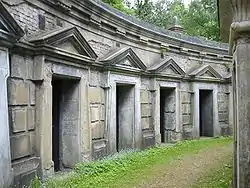
The cemetery's grounds are full of trees, shrubbery and wildflowers, most of which have been planted and grown without human influence. The grounds are a haven for birds and small animals such as foxes. The Egyptian Avenue and the Circle of Lebanon (previously topped by a huge, 280 years old Cedar of Lebanon, which had to be cut down and replaced in August 2019) feature tombs, vaults and winding paths dug into hillsides. The Egyptian Avenue and the Columbarium are Grade I listed buildings.
West Cemetery interments
- Jane Arden, Welsh-born film director, actor, screenwriter, playwright, songwriter, and poet.
- John Atcheler, ‘Horse slaughterer to Queen Victoria’
- Edward Hodges Baily, sculptor
- Beryl Bainbridge, author
- Julius Beer (and family members), owner of The Observer, .
- Jacob Bronowski, scientist, creator of the television series The Ascent of Man
- James Bunstone Bunning, City Architect to the City of London
- Robert Caesar Childers, scholar of the Orient and writer
- Edmund Chipp, organist and composer
- John Cross, English artist
- Philip Conisbee, art historian and curator
- John Singleton Copley, Lord Chancellor and son of the American painter John Singleton Copley
- Sir Charles Cowper, Premier of New South Wales, Australia
- Addison Cresswell, talent agent
- Charles Cruft, founder of Crufts dog show
- David Devant, theatrical magician
- Alfred Lamert Dickens, the younger brother of Charles Dickens
- Catherine Dickens, wife of Charles Dickens
- John and Elizabeth Dickens, parents of Charles Dickens
- The Druce family vault, one of whose members was (falsely) alleged to have been the 5th Duke of Portland.
- Joseph Edwards (sculptor), Welsh sculptor
- Thomas Edwards (author), (Caerfallwch), Welsh author and lexicographer
- Ugo Ehiogu, footballer
- Michael Faraday, chemist and physicist (with his wife Sarah), in the Dissenters section
- Lucian Freud, painter, grandson of Sigmund Freud, and elder brother of Clement Freud
- John Galsworthy, author and Nobel Prize winner (cenotaph, he was cremated and his ashes scattered)
- Stephen Geary, architect (most notably of Highgate Cemetery)
- Stella Gibbons, novelist, author of Cold Comfort Farm
- Henry Gray, anatomist and surgeon,[8][9] author of Gray's Anatomy.
- Radclyffe Hall, author of The Well of Loneliness and other novels
- William Hall, founder with Edward Chapman of publishers Chapman & Hall
- Edwin Hill, older brother of Rowland Hill and inventor of the first letter scale and a mechanical system to make envelopes
- James Holman, 19th-century adventurer known as "the Blind Traveller"
- Surgeon-General Sir Anthony Home, Victoria Cross recipient from Indian Mutiny
- Bob Hoskins, actor
- Georgiana Houghton, British artist and spiritualist medium
- David Edward Hughes, FRS, 19th-century electrical engineer and inventor
- Lisa Jardine, historian
- Thomas Landseer, younger brother of Sir Edwin Landseer (there is a cenotaph, Edwin was buried in St Paul's Cathedral)
- Robert Liston, surgeon
- Alexander Litvinenko, Russian dissident, murdered by poisoning in London
- William Lovett, Chartist
- George Michael, singer, songwriter, music producer and philanthropist. His mother's resting place is not far from his.
- Barbara Mills, (ashes) first female Director of Public Prosecutions
- Elizabeth de Munck, mother of celebrated soprano, Maria Caterina Rosalbina Caradori-Allan in grave with large carving of pelican in piety
- Samuel Noble, English engraver, and minister of the New Church
- George Osbaldeston, known as Squire Osbaldeston, sportsman, gambler and Member of Parliament
- Sherard Osborn, Royal Navy admiral and Arctic explorer
- Frances Polidori Rossetti, mother of Dante Gabriel, Christina and William Michael Rossetti
- Christina Rossetti, poet
- Gabriele Rossetti, Italian nationalist and scholar. Father of Christina and Dante Gabriel Rossetti
- William Michael Rossetti, co-founder of the Pre-Raphaelite Brotherhood
- Tom Sayers, pugilist, his tomb is guarded by the stone image of his mastiff, Lion, who was chief mourner at his funeral.
- Elizabeth Siddal, wife and model of artist/poet Dante Gabriel Rossetti
- Jean Simmons, actress
- Alfred Stevens, sculptor, painter and designer
- Sir Henry Knight Storks, soldier, MP, and colonial administrator
- Alfred Swaine Taylor, toxicologist, forensic scientist, expert witness
- Frederick Tennyson, poet, older brother of Alfred, Lord Tennyson
- Arthur Waley, translator and scholar of the Orient
- George Wombwell, menagerie exhibitor
- Ellen Wood, author known as Mrs Henry Wood, there is also a plaque for her in Worcester Cathedral
- Adam Worth, criminal mastermind. Possible inspiration for Sherlock Holmes' nemesis, Professor Moriarty. Originally buried in a pauper's grave under the name Henry J. Raymond
- Patrick Wymark, actor
War graves
The cemetery contains the graves of 318 Commonwealth service personnel maintained and registered by the Commonwealth War Graves Commission, in both the East and West Cemeteries, 259 from the First World War and 59 from the Second. Those whose graves could not be marked by headstones are listed on a Screen Wall memorial erected near the Cross of Sacrifice in the west cemetery.[10]
Visiting
The cemetery is maintained by the Friends of Highgate Cemetery Trust. They charge an entry fee to cover expenses for the tours and the maintenance of the property. The cemetery is a private cemetery and not generally open to the public.
The West Cemetery is accessible by ticketed guided tour only (mainly for safety reasons) on Saturday and Sunday afternoons or with prior booking for weekdays. However, the cost of the guided tour includes access to the East Cemetery and a map. The tour lasts for approximately one hour. The East Cemetery is accessible by a ticketed self-guided (entry includes a map) or a guided tour. Full terms can be found on the website.
In popular culture
- Several of John Galsworthy's Forsyte Saga novels refer to Highgate Cemetery as the last resting place of the Forsytes; for example, Chapter XI, "The Last of the Forsytes," in To Let (1921).
- In the 1970 film Clegg directed by Lindsay Shonteff, Harry Clegg, played by Gilbert Wynne, walks into the Cemetery through the Egyptian Avenue entrance.[11]
- Footage of Highgate appears in numerous British horror films, including Taste the Blood of Dracula (1970), Tales from the Crypt (1972) and From Beyond the Grave (1974).
- In the BBC TV series Porridge, Fletcher claims that his eldest daughter, Ingrid, was conceived on Karl Marx's tomb.
- Herbert Smith is shadowed through Highgate Cemetery in Visibility, a murder/espionage/thriller by Boris Starling.
- Highgate Cemetery is the sixth level of the Nightmare Creatures game.
- In Len Deighton's alternative history novel SS-GB and its TV adaptation, a bomb is detonated in the tomb of Karl Marx when his remains are exhumed by German occupation forces to be presented to the Soviet Union.
- Fred Vargas's novel Un lieu incertain starts in the cemetery.
- Barbara Hambly's vampire novel, Those Who Hunt the Night, has the main characters visiting Highgate at one point to examine the remains of a vampire who had taken over an abandoned tomb.
- Stated in the acknowledgments as the inspiration for the setting of Neil Gaiman's The Graveyard Book.
- Audrey Niffenegger's book Her Fearful Symmetry (2009) is set around Highgate Cemetery; she acted as a tour guide there while researching the book.[12]
- In the novel Double or Die (2007), a part of the Young Bond series, Ludwig and Wolfgang Smith plan to kill Bond in the cemetery.
- Tracy Chevalier's book Falling Angels (2002) was set in and around Highgate Cemetery. The two main protagonists met there as children while their parents were visiting adjacent family graves and they continued to enjoy meeting up and playing there.
- The movie Hampstead (2017) features a few scenes in the cemetery.
- The climax of John Steele's novel Seven Skins (2018) was set in the Egyptian Avenue and Circle of Lebanon, among other locations in the West Cemetery.
- The movie Fantastic Beasts: The Crimes of Grindelwald (2018) features scenes towards the end of the film in the cemetery before the famous Cedar tree was removed.
Notable gravesites
- Douglas Adams, Author (1952–2001)
- Jeremy Beadle, Writer, Presenter, Curator of Oddities (1948–2008)
- George Eliot, poet, writer, novelist, journalist.
- Sir William Charles Ross, painter to The Queen and Court. Portrait miniature artist.
- Michael Faraday, scientist, discoverer of electromagnetic induction.
- Leon Griffiths, creator of Minder
- Radclyffe Hall, English author and poet, Seminal Lesbian work The Well of Loneliness
- Theodore Hope, British colonial administrator and writer (1831–1915)
- Claudia Jones, Trinidadian born Communist, black nationalist, and founder of the Notting Hill Carnival and Britain's first major black newspaper, West Indian Gazette (1915-1964)[13]
- Roger Lloyd-Pack, actor known for Only Fools and Horses and The Vicar of Dibley (1944–2014)
- Charles Lucy, British artist, (1814-1873) whose most notable painting was The Landing of the Pilgrim Fathers
- Karl Marx, philosopher, historian, sociologist and economist (memorial after his reburial, with other family members)
- George Michael, singer/songwriter (1963–2016)
- Bruce Reynolds, (1931–2013) mastermind of the Great Train Robbery (1963)
- Christina Rossetti, Poet (1830–1894)
- Tom Smith (1823-1869), inventor of the Christmas cracker
- Herbert Spencer, philosopher, sociologist, political theorist of Victorian era.
- Alan Sillitoe, seminal postmodern novelist, poet, and playwright (1928–2010)
- Jeanette Threlfall, Victorian-era hymnwriter, poet
- Aleksander Litvinenko, Russian defector, British spy
- Adam Worth, crime boss
- Mehmet Aksoy, press officer for the Kurdish YPG, killed by ISIS in 2017.[14]
Gallery






 Carl Rosa grave
Carl Rosa grave Highgate Cemetery East (2010)
Highgate Cemetery East (2010)
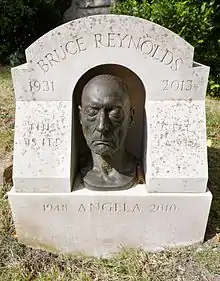 The grave of Bruce Reynolds
The grave of Bruce Reynolds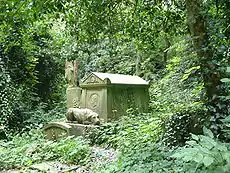 The tomb of Tom Sayers
The tomb of Tom Sayers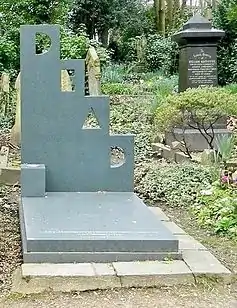 The grave of Patrick Caulfield, RA
The grave of Patrick Caulfield, RA The Grave of Mansoor Hekmat
The Grave of Mansoor Hekmat The Grave of Anna Mahler
The Grave of Anna Mahler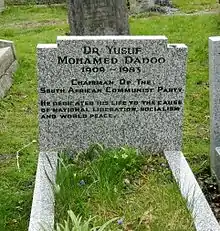 The Grave of Yusuf Dadoo
The Grave of Yusuf Dadoo The Grave of Eric Hobsbawm
The Grave of Eric Hobsbawm The Grave of Jeremy Beadle
The Grave of Jeremy Beadle
References
- "Frequently Asked Questions". Highgate Cemetery. Highgate Cemetery. Archived from the original on 16 February 2013. Retrieved 21 August 2014.
- Historic England, "Highgate Cemetery (1000810)", National Heritage List for England, retrieved 21 June 2017
- "Highgate Cemetery". Historic England. Retrieved 24 April 2010.
- "History". Highgate Cemetery. Highgate Cemetery. Archived from the original on 24 January 2017. Retrieved 21 August 2014.
- A Brief History of Highgate Cemetery
- News, Google
- "Tomb raiders' failed attack on Marx grave", Camden New Journal, UK
- GRO Register of Deaths: JUN qtr 1861 1a 174 St Geo Han Sq – Henry Gray
- "DServe Archive Persons Show". .royalsociety.org. Archived from the original on 15 April 2013. Retrieved 18 March 2013.
- "Cemetery Details: Highgate Cemetery". Commonwealth War Graves Commission. Commonwealth War Graves Commission. Retrieved 21 August 2014.
- "The Bullet Machine" – via www.imdb.com.
- Niffenegger, Audrey (3 October 2009). "Audrey Niffenegger on Highgate Cemetery". The Guardian. Retrieved 3 October 2009.
- Davis, Angela (20 June 2019). "Angela Davis praises CPUSA for its history "of militant struggle"". PeoplesWorld.org. Retrieved 20 June 2019.
- "Farewell to YPG's Mehmet Aksoy in London". ANF. 11 November 2017.
External links
| Wikimedia Commons has media related to Highgate Cemetery. |